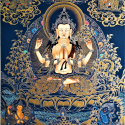Description
Guanyin is hand painted by Ratna Kumar Lama as a beautiful young woman posing in her traditional reclined position, donned in a flowing robe and wearing royal jewels.
Guanyin or Kuan Yin, in Chinese Guanshiyin 觀音菩薩 means “She who hears/perceive the cry of the world”. She is the goddess of mercy in Taoism, and Bodhisattva of compassion and forgiveness.
Quan Yin, according to ancient Chinese scriptures, was the mother goddess of China.
She became so popular to be adopted into the Buddhist pantheon and today is one of the more revered Bodhisattva in Mahayana Buddhism.
Due to the popularity of Quan Yin all around Asia, she is known by many names. It is pronounced Gwun Yam or Gun Yam in Cantonese. In Japan, Guanyin is known as Senju Kannon (観音).
In Tibetan the name is Chenrezig
Kuan Yin, Goddess of Mercy can bring children (generally sons, but if the mother asks for a daughter she will be beautiful), protect in sorrow, guide seamen and fishermen (thus we see her “crossing the waves” in many poses). According to one ancient legend, her name was Miao Shan, and she was the daughter of an Indian Prince. Youthful and serene, she chose to follow a path of self-sacrifice and virtue and became a pious follower of Buddha, herself attaining the right to Buddhahood but remaining on earth to help mankind. Another Miao Shan legend was that the son of the dragon king had taken the form of a carp and was caught by a fisherman and displayed for sale in the market place. Miao Shan sent her servant to buy the fish and released it.
Kuan Yin is holding a willow branch in her left hand and a jar with holy water in her right hand. She used willow branches to anoint the sick and dying with the nectar of life.
“Guanyin’ when translated from Chinese means “he who listens to the sounds”.
Use this inspirational Kuan Yin Thangka Painting for protection, for fertility, and for financial success.


















Reviews
There are no reviews yet.